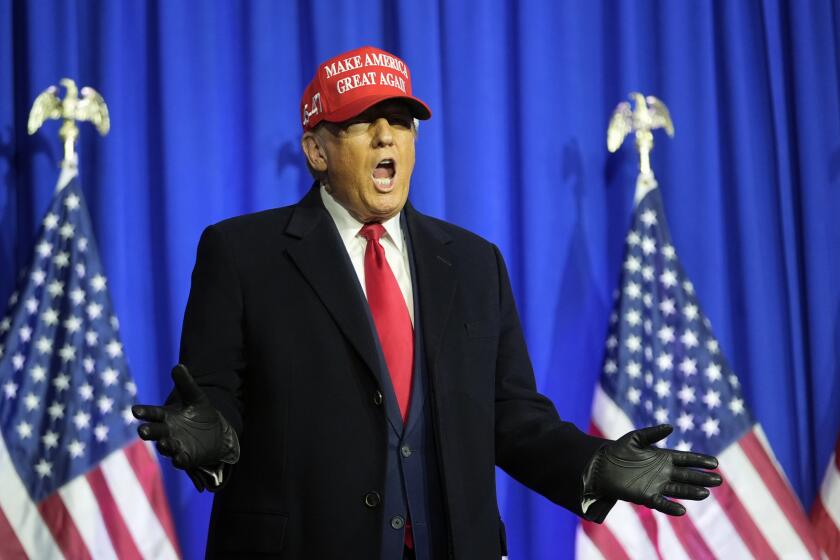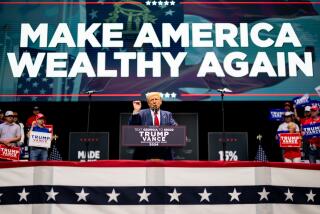Harris’ economic plan is a grab bag of targeted subsidies. Trump’s is nonsense on stilts

- Share via
WASHINGTON — The presidential campaign produced plenty of noise last week, but the race still appears mired in a virtual electoral-college tie.
Polls show Vice President Kamala Harris ahead of former President Trump by about three points in the national popular vote, but that’s not enough to guarantee a majority of the electoral votes she needs to win. President Biden won the popular vote by about 4.5% in 2020 and barely squeaked through the electoral college. Hillary Clinton won the popular vote by about 2.1% in 2016 and lost.
So the outcome is in the hands of a few million undecided or potentially “movable” voters in a handful of swing states — and most of those voters say their top concern is the economy: which candidate seems more likely to bring about economic growth, higher incomes and lower prices (or, more realistically, a lower rate of inflation).
And that’s why, as the race moves into its last five weeks, it’s beginning to sound like a long debate over competing economic policy platforms — even if the two candidates can’t agree to debate on the same stage.
From Harris, ‘an a la carte menu’
Harris has been gradually revealing an economic plan that can be described as Biden 2.0, an updated list of priorities her boss fought for (although, in a speech unveiling the plan last week, she never mentioned his name). It’s mostly a grab bag of targeted subsidies: for parents of small children, for first-time homebuyers, for small businesses, for manufacturing and technology. In an echo of her unmentioned boss, she summarized it as a plan to help families “to not just get by, but be able to get ahead…. When the middle class is strong, America is strong.”
“I am a capitalist,” she added, presumably to reassure moderate voters who have heard Trump caricature her as a “radical Marxist lunatic.”
In over-the-top attacks, Donald Trump calls Vice President Kamala Harris a communist, sometimes even a fascist. Why his wild swings aren’t connecting.
Reviews have been mixed. Republicans predictably dismissed the plan as warmed-over Bidenomics (although, with the economy growing smartly, “Bidenomics” may not have the sting it once did). Democrats praised it on the record, but some added — under cover of anonymity — that they weren’t sure a clear overall message emerged from the list of targeted proposals.
“This feels like an a la carte menu,” said one. “How many people are planning to start a small business next year?”
An undecided voter in Georgia echoed that critique in a focus group — before Harris’ speech — organized by Republican Voters Against Trump (the people in the focus group were not members). “She’s mentioned small business and babies, but … we need something for everyone,” said the woman, identifed only as “Jennifer.”
As many as 10% of voters are still undecided. Many say they dislike Trump but don’t know enough about Harris.
Trump’s magical thinking
Still, Harris’ plan is head and shoulders above the grandiose but gaseous promises Trump has offered. The former president claims he will deliver faster growth, lower prices and massive tax cuts, but has offered no realistic blueprint for how he’d get there.
“Prices will come down and come down dramatically and come down fast,” he pledged last month. But when a reporter for the conservative Sinclair Broadcast Group asked how he would make prices drop, Trump’s response was an untethered excursion into magical thinking.
“They come down with energy and they come down with interest rates,” he said. “We’re going to get energy [prices] down by 50% in 12 months. We’re gonna have it. It’s gonna be a major smash on energy.”
Trump wants the right to fire civil servants he sees as disloyal: Cue IRS audits for Trump enemies, anti-vaxxers in the FDA, revenge prosecutions.
That’s not a plan, it’s a pipe dream. A president has no power to make energy prices drop by 50%. Trump has promised to deregulate the oil and gas industry and open more federal land to drilling; that’s probably what he means by “major smash.” But economists say it’s unrealistic to expect those steps to produce major price drops in a global energy economy.
A president has no power to make interest rates go down either. Those rates are set by the Federal Reserve, which was designed to be independent from political pressure. Fed Chairman Jerome H. Powell is scheduled to be in his job at least until 2026, and he can’t be fired over policy differences.
Trump has offered conflicting specifics about one piece of his economic vision: high tariffs on imports. He’s mused about tariffs ranging from 10% or 20% (on imports from everywhere) to 60% (on China, sometimes other countries too) to 100% (on automobiles built in Mexico); the details seem to change depending on his mood.
Most economists say those are terrible ideas. Tariffs almost always produce higher prices for both imported and domestically made goods, fueling inflation. And most foreign countries hit by tariffs retaliate by slapping tariffs on U.S.-made goods, reducing American exports. But presidents have wide power to impose tariffs, so this may be one economic promise Trump can deliver.
Trump has also promised tax cuts to just about everybody, including corporations, Social Security recipients and anybody working overtime. He has never bothered to say how he would pay for the resulting cuts to federal revenue beyond his magical “major smash.”
Tariffs on foreign goods aren’t paid by other countries; they’re paid by American consumers — and they often fail to protect jobs.
So who’s winning?
Who’s winning this asymmetrical debate? Like the overall campaign, it may be turning into a draw.
Trump started the campaign with a wide advantage over Biden in polls asking which candidate would be better at handling the economy, especially inflation.
But in recent weeks, Harris has chipped away at Trump’s margin. A few surveys have suggested that she has erased it entirely, although those polls may be outliers.
Even getting close is an important achievement for the Harris campaign.
“The economy is traditionally an issue on which Republicans have the advantage,” noted Doug Sosnik, a Democratic strategist who helped President Clinton win reelection in 1996. “It’s hard for Democrats to win it. But if you can’t win an issue, you at least want to neutralize it — and she’s done a pretty good job of that.”
So maybe Harris’ piling of one economic proposal atop another is paying off. Maybe Trump’s incoherence on policy is finally catching up with him.
And maybe good economic news — a growing economy, easing inflation and lower interest rates — is finally seeping into voters’ consciousness, allowing Harris to reap some political benefit from the soft landing Biden hoped would earn him a second term.
Whatever the reason, Harris has no choice but to keep grinding away on the issue.
“We have never won an election where we have been behind on the economy. We have to be at least even,” veteran Democratic pollster Celinda Lake told the New Yorker last week. The remaining five weeks of Harris’ campaign should be “a full court press to establish her economic credentials,” she said.
Voters who are focused on abortion have already made up their minds. So have voters who are focused on immigration.
But voters who are focused on the economy and inflation are still in play. That’s where the last remaining movable votes are. That’s why the economic debate will be the last, and perhaps decisive, battle of this campaign.
More to Read
Sign up for Essential California
The most important California stories and recommendations in your inbox every morning.
You may occasionally receive promotional content from the Los Angeles Times.

















